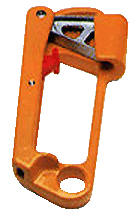For convenience, I've divided the ascending
devices in my collection into a number of categories. Although
there are more rigorous methods to classify ascending devices,
I've chosen an informal approach that I think will be easier for
most people to follow than some purely academic method.
| ID |
This
is just my catalog number so that I can keep these straight |
| Weight |
Weights are in grams. Webbing, slings, etc. are not included. |
| Height, Width, Thickness |
I've given the dimensions
in millimeters. The measurements are in perpendicular directions.
I've chosen to measure the maximum dimensions instead of the
most obvious dimensions. Sometimes this leads to numbers that
are more than what you would expect - for example, the thickness
of a bent plate would be more than the thickness of the unbent
plate. |
| Standard Volume |
The standard volume
is just the product of the height, width, and thickness divided
by 1000. This gives a volume in milliliters of a box that the
device will fit into. Odd shaped devices are penalized by this
formula, but since they are generally harder to pack, this number
might be useful. |
| Channel Diameter |
This is the diameter
of the rope channel in millimeters. On most of these ascenders
the dimension varies a bit depending on where it is measured. |
| Cam Angle |
Most eccentric cam
ascenders use an equiangular spiral for the shape of the cam,
although some use a circular arc and others use more complex
patterns (e.g., two spirals). I've given the equivalent cam angle
that I measured. I believe this is accurate to within about ±2
degrees. |
| Tooth Pattern |
The tooth pattern
is best described by example: (F)(2.H)^2(3.2) would have, starting
at the top, a flat area (F), a row of two teeth, a hole (H),
another row of two teeth, another hole (the ^2 means the pattern
is repeated two times), a row of three teeth and finally a row
of 2 teeth. In other patterns, "S" stands for a single longitudinal
slot, and "Z" stands for wide "Z"-shaped (not conical)
teeth |


 Ascenders
Ascenders